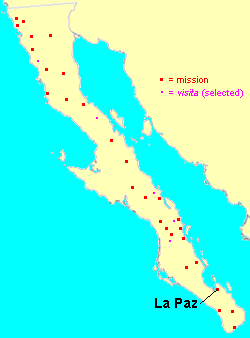
Misión de Nuestra Señora del Pilar de La Paz Airapí
Encyclopedia

Mission La Paz was established by the Jesuit missionaries Juan de Ugarte and Jaime Bravo in 1720, at the location of the modern city of La Paz
La Paz, Baja California Sur
La Paz is the capital city of the Mexican state of Baja California Sur and an important regional commercial center. The city had a 2010 census population of 215,178 persons, but its metropolitan population is somewhat larger because of surrounding towns like el Centenario, el Zacatal and San Pedro...
, Baja California Sur
Baja California Sur
Baja California Sur , is one of the 31 states which, with the Federal District, comprise the 32 Federal Entities of Mexico. Before becoming a state on October 8, 1974, the area was known as the South Territory of Baja California. It has an area of , or 3.57% of the land mass of Mexico and comprises...
, Mexico.
La Paz was the location of the earliest Spanish activity in Baja California, and was frequently the site of conflicts between the Spanish and the local Guaycura
Guaycura
The Guaycura were a native people of Baja California Sur, Mexico, occupying an area extending south from south of Loreto to Todos Santos. They contested the area around La Paz with the Pericú....
and Pericú
Pericúes
The Pericú were the aboriginal inhabitants of the Cape Region, the southernmost portion of Baja California Sur, Mexico...
Indians. Fortún Ximénez
Fortún Ximénez
Fortún Ximénez was Spanish sailor who led a mutiny during an early expedition along the coast of Mexico and is the first European known to have landed in Baja California....
, muntineer on an expedition sent by Hernán Cortéz, landed at La Paz in 1533. Two years later, Cortés himself led a large party that attempted but failed to establish a settlement. Sebastián Vizcaíno
Sebastián Vizcaíno
Sebastián Vizcaíno was a Spanish soldier, entrepreneur, explorer, and diplomat whose varied roles took him to New Spain, the Philippines, the Baja California peninsula, the California coast and Japan.-Early career:...
in 1596 gave it its anomalously pacific name. Isidro de Atondo y Antillón
Isidoro de Atondo y Antillon
The Spanish admiral Isidro de Atondo y Antillón is best known for his role in unsuccessful attempts to establish colonies on the Baja California peninsula in 1683–1865....
and Eusebio Francisco Kino
Eusebio Kino
Eusebio Francisco Kino S.J. was an Italian Roman Catholic priest who became famous in what is now northwestern Mexico and the southwestern United States in the region then known as the Pimaria Alta...
attempted to establish a mission settlement in 1683 but again failed because of conflicts with the native inhabitants. When Jesuit missions finally took root in Baja California after 1697, the initial focus of activity was to the north, in the area around Loreto.
The Jesuits finally returned to the site of Airapí (probably a Guaycura name) in 1720, in coordinated expeditions from Loreto that traveled both by sea (under Ugarte and Bravo) and overland (under Clemente Guillén). The mission had little success, however. It was sacked in the Pericú Revolt of 1734 and finally abandoned in 1748, when its Indian neophytes were relocated to Todos Santos
Misión Santa Rosa de las Palmas
Two names were given in succession to the Jesuit mission at Todos Santos in southern Baja California Sur, Mexico: Santa Rosa de las Palmas, and Nuestra Señora del Pilar de la Paz....
.
See also
- Spanish missions in CaliforniaSpanish missions in CaliforniaThe Spanish missions in California comprise a series of religious and military outposts established by Spanish Catholics of the Franciscan Order between 1769 and 1823 to spread the Christian faith among the local Native Americans. The missions represented the first major effort by Europeans to...

